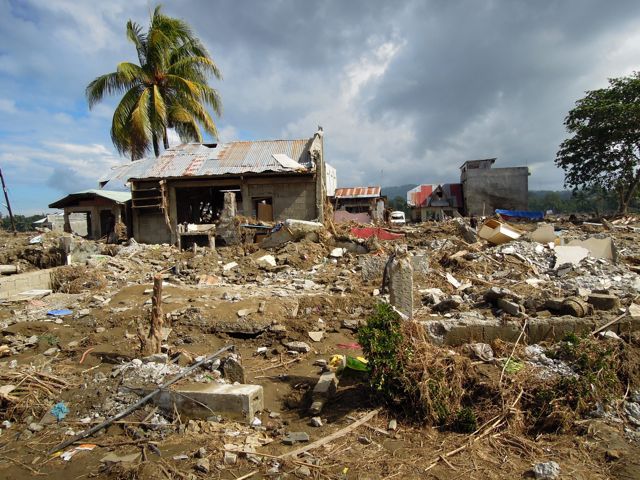My friend, Dr. Greg C. invited me to pass by Iligan City and we did.
As I showed earlier, we could see the very sad effects of Typhoon Sendong by the highway and how it affected the bridges, the homes and transportation.
They say that the Mandulog River grew wider to a kilometer or more and rose to heights like it never did before for the first time they ever experienced.
But they (some people we talked to like the driver and the people in the stores) claimed that it was not only water that flowed but also huge logs from the mountains.
They say if it was just water, the bridges, houses and transportation wouldn't be physically "beaten" and "broken".
They also say it is the logs which caused obstruction to parts of the river, thus, the overflow!
The water flowed to places even far from the river!
My friend was lucky that they were aware that the water level was rising and so they were able to prepare. But even his car was pushed meters away from the current.
He wanted to show us a deeper look of the devastation of Typhoon Sendong in Iligan. He brought us to a subdivision, Orchid Homes which was closer to the river.
But the houses here were made of concrete and still they were destroyed!!!
These are news related to the aftermath of Typhoon Sendong in Iligan.
Geologist on Sendong flashflood in Iligan: 'Like a tsunami but with more debris'
30-Dec-11, 4:39 PM | Joseph Holandes Ubalde, InterAksyon.com
Dr. Mahar Lagmay, geologist and professor at the University of the Philippines National Institute of Geological Sciences, said the rampaging Mandulog river in Iligan City collected a lot of things as the water cascaded toward the sea. Among the deadly debris that it eroded and carried were sand, gravel, and huge logs, allegedly from illegal mining in the mountains.
“It’s like a tsunami but with more debris,” he said in a press conference at the University of the Philippines in Diliman.
A tsunami is a series of ocean waves or surges onto land brought about by an earthquake.
Meawhile, Lagmay described the flashflood that devastated Iligan as a “hyperconcentrated flood” that packed speed and power. Due to the force of the water, 35 kilometers of terrain from the 50 km Mandulog river was devastated. It wiped out most of the Orchid Homes Subdivision in Santiago town, where 500 families lived before the floods hit.
Based on Lagmay’s initial assessment, entire communities by the river in Iligan were severely hit by the “raging floodwater,” and even reached areas as far away as one kilometer from the body of water. This meant, he added, that even those at a relative distance from the river, who normally should feel safe, were not spared by the wall of water that carried with it the deadly debris.
According to the latest tally of the National Disaster Risk Reduction and Management Council, 381 of the more than 1,200 killed by Sendong came from Iligan City. Of these, 249 remain unidentified.
Lagmay said Iligan’s devastation was worse than that of Cagayan de Oro City, which recorded the most bodies from Sendong as of Friday. He earlier said the destruction in Iligan surpassed or, at the very least, equalled that caused by the massive 2006 landslide that buried the entire village of Guinsaugon in St. Bernard, Southern Leyte.
Rains are to blame
Lagmay, who was part of the 22-man team of doctors, geologists and engineers from UP who went to Iligan City, said it was more likely that the massive rainfall, not illegal logging, caused the devastation in the area.
“Illegal logging aggravated the floods but the primary reason for this is the extreme rainfall brought by Sendong,” Lagmay said.
Here are photos of Orchid Homes which I would like to share with you. These are the images taken 14 days after the storm! |
| cars, SUVs, and even trucks are destroyed |
 |
| mud... and lots of mud fill the houses! |
 |
| and even the rooftops saw bad times! |
 |
| the river has grown wider and wilder! |
 |
| effect of the raging waters with lots of debris tangled in the rubble! |
 |
| many houses are unliveable! |
 |
| and nearer to the river, the houses could no longer be identified!...I wonder how the inhabitants are? They are the most likely mortalities from this calamity. |
 |
| trying to salvage some appliances... |
 |
| and then, there was none! |
 |
| checking out the area... |
 |
| This subdivision is filled with houses... but look at it now! |
 |
| the roads are cleaned and the mud moved to the sides |
Here is evidence of help from the Province of Cebu and also help from other sources.
I found this orchid still in bloom in one of the homes.
.I was amazed how the orchid remained beautiful in one of the houses in Orchid Homes, as if it is a sign to rise from all these devastations... an inspiration to continue to live and remain resilient, no matter how weak we seem.
Live on... Live strong, Iligan!!!
Again, thanks Dr Greg C. for this eye-opening experience!
Again, thanks Dr Greg C. for this eye-opening experience!













No comments:
Post a Comment